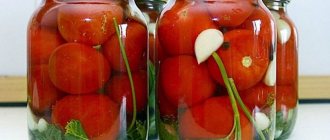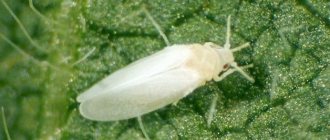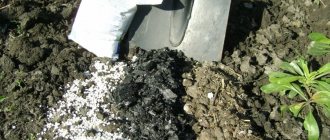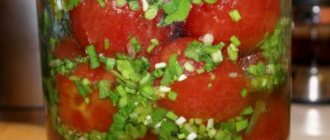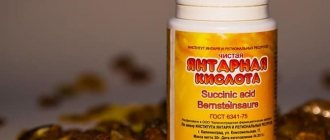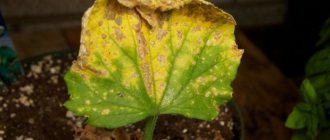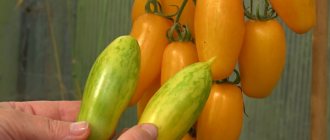The benefits of natural fertilizers
Advantages of natural folk remedies:
- natural composition of nutrients, allowing you to get an environmentally friendly harvest;
- do not harm the environment;
- long-lasting effect after use;
- not harmful to humans.
Natural means for feeding plants
Natural fertilizers for tomatoes also have disadvantages:
- some types of fertilizers (egg shells) are slowly absorbed by plants;
- incompletely broken down microelements (fresh manure) can harm tomatoes and attract insect pests;
- It is impossible to accurately calculate the rate of applied nutrients.
Why don't tomatoes grow?
The process of active growth in tomatoes begins after they are planted in open ground. However, there are two options for the development of events: the seedlings have taken root well in the new place and are developing quickly, or they are growing poorly and then stop developing altogether. Reasons for slow growth may be :
- clogged, compressed, airtight soil;
- unsuitable soil composition;
- adverse weather conditions;
- lack of nutrients in the soil;
- improper care.
How to feed tomatoes
To fertilize tomatoes, they often use:
- wood ash;
- chicken droppings;
- nettle infusion;
- iodine;
- whey;
- yeast;
- ammonia.
Recipes for fertilizers for tomatoes
Characteristics of natural fertilizers:
- Wood ash protects tomatoes from infection with fungal diseases. It neutralizes excess soil acidity, stimulates the proliferation of beneficial microorganisms, and has a long-lasting effect.
- Chicken manure contains a large amount of nitrogen, phosphorus, strengthens the stems and leaves of plants. The fertilizer is quickly absorbed, accelerates the ripening of the crop, and promotes abundant fruiting.
- Nettle infusion , especially young ones, contains a lot of nitrogen, carbon, and iron. Top dressing enriches tomatoes and soil with potassium, calcium, and magnesium.
- Iodine protects plants from fungal diseases, strengthens the immune system, promotes the absorption of nutrients by the root system, increases productivity, and accelerates the ripening of tomatoes.
- The serum is completely safe for plants and contains potassium, calcium, phosphorus, manganese, and nitrogen. Fertilizing improves the absorption of nutrients from the soil, prevents infection with late blight and fungal diseases.
- Yeast is an excellent growth stimulator and strengthens stems and roots.
- Ammonia contains nitrogen and accelerates the development of green mass of plants.
Why fertilize plants?
At each stage of development, tomatoes need feeding with useful elements.
They begin to introduce them with the appearance of the third true leaf. The very first fertilizing is carried out after planting in the ground. If you want to learn more about all the stages of fertilizing tomatoes, read the material at the link.
The main nutritional components for this vegetable crop are nitrogen, potassium, phosphorus, iron, magnesium.
When there is a deficiency of one or another substance, the plant develops various abnormalities in growth and development. Eg:
- A lack of phosphorus causes slow growth, the leaves acquire a reddish-purple hue, and the edges of the leaf blade curl. This substance is necessary for the formation of the root system and improving the taste of the fruit.
- With a severe lack of nitrogen, you can see sluggish, light green, lifeless leaves, a thin stem, and underdeveloped roots.
- Potassium deficiency is diagnosed when blossom end rot is detected. Thanks to this component, tomatoes gain resistance to various infectious pathogens and temperature changes.
- Pale leaves with obvious green veins indicate iron deficiency and developing chlorosis.
- The uneven green color of tomato leaves, the so-called marble effect, is due to a lack of magnesium .
Proper and timely feeding will help correct this difficult situation.
Important. Excess nitrogen fertilizers lead to the growth of green mass in tomatoes to the detriment of flowering and fruits.
If the plants grow rapidly, but the flowers do not set, most likely you overfed them.
Feeding tomatoes in open ground
Tomatoes in the beds are fertilized several times per season:
- After planting the seedlings, during the formation of the second pair of true leaves. Tomatoes are fed with infusions of nettle, dandelion, and a weak solution of iodine. Herbal compositions help protect plants from late blight and accelerate the ripening of crops.
- When buds appear. The soil under the bushes is enriched with wood ash. It is a natural source of potassium. The ash does not contain chlorine.
- During flowering and ovary formation. Whey with iodine is used for feeding. Fertilizer promotes early fruiting and serves as an additional prevention of late blight.
Whey with iodine
Feeding tomatoes with whey with iodine.
Recipe for preparation and use of fertilizing:
- Add 1 liter of whey and 20 drops of pharmaceutical iodine to a bucket of water (10 liters) and mix thoroughly.
- Pour one liter of the composition under the bush.
Foliar feeding of tomatoes with ash
In addition to adding wood ash to the soil, it is used to spray bushes:
- Add 300 g of ash to 3 liters of water and boil for half an hour.
- Infuse the solution for about 5-6 hours, add water to a volume of 10 liters. To better fix the composition on the leaves, add a little liquid soap and mix well.
- The finished mixture is filtered and the tomato tops are sprayed.
Nettle decoction
Fertilizer for tomatoes from nettles.
Herbal infusion is prepared from young nettle leaves:
- The container is filled 2/3 with nettle greens, then filled with water, and covered with a lid. Keep in a warm place for seven to ten days.
- Add 1 liter of the prepared solution to a bucket of water, mix and water the bushes at the root, 1-2 liters at a time. The frequency of feeding is no more than once every two weeks.
Fertilizer with iodine solution
Preparation and use:
- 1-2 drops of iodine are diluted in 3 liters of heated water, and young plants planted in the ground are watered.
- Add 4-5 drops of iodine to a bucket of water, apply 2 liters per adult bush.
Why additional nutrition for tomatoes?
The vegetable crop tomato is grown in every garden. For full development and fruiting, plants need carbon dioxide, nitrogen, phosphorus, potassium, magnesium, iron, zinc, copper, calcium and oxygen. This is the supply of useful elements and microcomponents, without which high yields and excellent taste are impossible.
Carbon dioxide, for example, takes part in the growth of shoots and leaves. Oxygen loosens the soil and nourishes the root system. Nitrogen promotes the formation of shoots, the formation of flowers and ovaries. All these useful compounds are found in large quantities in human food products, which means they are beneficial to plants.
Natural fertilizers for tomatoes in greenhouses
When growing tomatoes in greenhouses, fertilizing is applied as follows:
- 7–10 days after planting the seedlings, water it with a solution of ammonia . Ammonia contains 82% nitrogen. It is the main food product of plants. Nitrogen is an effective stimulator of green mass growth, strengthens stems and leaves, and eliminates yellowness. Repeated watering is carried out when stepsons form on the bushes.
- Banana peel fertilizer contains a lot of potassium and phosphorus. Added a week before transplanting seedlings into the greenhouse, it improves the survival rate of plants. Fertilizing is carried out during the formation of ovaries and during fruiting, this strengthens the flower stalks and accelerates the ripening of tomatoes.
- Eggshells contain phosphorus, iron, magnesium, sulfur, zinc, a small amount of fluorine, manganese, and potassium. Calcium carbonate is valuable. It promotes intensive metabolism, accelerates growth, and supplies plants with oxygen. The crushed shells are applied to the soil immediately before planting. Water the tomatoes with infusion every 2-3 weeks.
- Infusions of chicken manure and mullein are used 3 weeks after planting the seedlings in the greenhouse. Repeated watering with infusions is done during the formation of ovaries. Top dressing supplies the soil and tomatoes with organic substances and microelements (potassium, calcium, nitrogen, phosphorus, magnesium, boron, etc.). Fertilizers stimulate plant development, improve flowering and fruiting.
Ammonia
Fertilizing tomatoes with ammonia in open ground
There are two ways to prepare and use the solution according to folk recipes:
- Add 10-20 ml of ammonia (10%) to a bucket of water (10 l). When planting seedlings, pour 0.5 liters into each hole. In the future, watering is done at the root of tomatoes no more than twice a week, and feeding is done no more than five times. If there is a lack of nitrogen, the solution is reapplied.
- For foliar feeding, 10 ml of ammonia is diluted in a bucket of water, 10 ml of liquid soap (or 10 g of laundry soap) is added. Treat fruit-bearing bushes with the product no more than once a week.
Banana peel infusion
The process of preparing fertilizer for tomatoes from banana peels.
Preparation and use of banana peel infusion:
- The skins are dried before use to reduce the content of chemicals that manufacturers and sellers treat bananas with.
- 3-4 skins are placed in a three-liter jar, filled with warm water, and left for 3-5 days. The finished infusion is filtered and diluted in equal parts with water. Water once a week with 100 ml per tomato bush.
Eggshell
An effective folk recipe for feeding tomatoes:
- Dry the shells of 3-4 eggs, chop them, place them in a liter jar, and add hot water. Cover the container loosely with a lid and keep in a dark place for 7-10 days.
- The finished solution will be cloudy and smell of hydrogen sulfide. Before use, dilute one part of the product with three parts of water and apply it under the bushes.
Chicken droppings and mullein
Fertilizing from chicken manure for tomatoes
How to prepare and use folk remedies for feeding tomatoes:
- Place fresh chicken manure in a bucket, add water in a ratio of 1:20, and leave for 10 days. Due to the high concentration of phosphorus and nitrogen, watering is done not under the bushes, but between the rows at the rate of 5-6 liters per square meter. m.
- Add 1 liter of dry chicken manure to 1 liter of water, close the container tightly, leave for 1-2 weeks, stirring occasionally. Before use, the solution is diluted with water in a ratio of 1:10, and 0.5 liters are poured per bush.
- Fresh manure is diluted in water (proportion 1:5), mixed thoroughly, covered and infused for two weeks. Before use, the mullein solution is diluted again with water (1:2), and the bushes are watered at the root level, 0.5-1 liter each.
What you need for tomato seedlings
Many people believe that vermicompost, granular compost and other organic fertilizers sold in stores can be added to the soil with seedlings in unlimited quantities. As a result, the plants begin to “fatten” and gain green mass. Such seedlings will not produce a good harvest in the future, since they were overfed with nitrogen contained in the fertilizer.
Latest articles for gardeners, gardeners and flower growers
How to grow petunia from seeds at home for seedlings
Planting carrots in spring sowing when to sow how to plant correctly
When to plant zinnia seedlings in 2021 according to the lunar calendar
Pruning an apple tree in spring for beginners in pictures step by step
The fact that seedlings do not have enough nitrogen can be determined by the following signs:
· plants look stunted;
· the lower leaves turn yellow or even fall off.
Attention! If it's not just the lower leaves that are turning yellow, you're most likely overwatering your seedlings. With a lack of nitrogen, only the lower leaves turn yellow.
With a lack of phosphorus, the undersides of the leaves, the veins on the leaves and the stems turn purple.
If you grow tomato seedlings in nutritious soil, then the plants cannot lack zinc, boron, molybdenum and copper. These substances are consumed in such small quantities that there is no need to add them specifically.
Chlorosis or iron deficiency occurs when seedlings are exposed to too much light. Plants should be allowed to rest, that is, they should be in the dark for 10-12 hours.
A lack of calcium will only appear in the garden. The plants will begin to be affected by tomato blossom end rot.
Tomato seedlings can be fed little by little throughout their growth. If the plants grow well and look healthy, use ready-made fertilizers according to the instructions (once every 7-10 days), but make the concentration 2 times less.
Make sure that the plants do not start to fatten! If the leaves become too fatty, green and begin to curl, stop feeding immediately!
Types of feeding for seedlings
Folk remedies for fertilizing tomatoes from onion peels or yeast:
- An infusion of onion peels is used instead of regular waterings or alternates with them. Pour 2-3 handfuls of husks into a liter jar, add hot water, leave for a day, and filter.
- to dry yeast (10 g). spoons of sugar, dissolved in a small amount of warm water. The resulting mixture is added to a bucket of water and infused. To feed the seedlings, the resulting solution is diluted again with water 1:5.
- A pack of fresh yeast (200 g) is diluted with a liter of warm water and left in a warm place for at least 3 hours. The resulting solution is diluted with a bucket of water. Tomato seedlings are watered with yeast fertilizers 5-7 days after transplanting into the ground, 0.5 liters per bush.
When to feed
Experienced gardeners recommend feeding tomato seedlings for the first time a week after picking. But once again I would like to note that if the tomatoes are plump, healthy and green, they have enough nutrition and do not need to apply fertilizer.
If you decide to feed your seedlings, first water them with plain water so as not to burn the roots with feeding.

